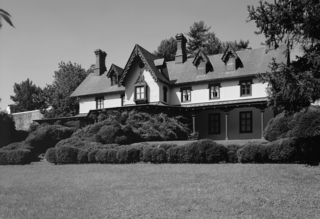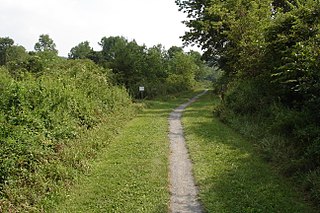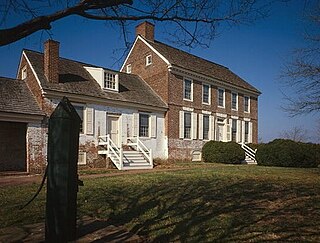
The Shot Tower located in Dubuque, Iowa, is one of the last remaining shot towers in the United States. It is listed on the National Register of Historic Places and remains a recognized symbol of the city. At its location near the Mississippi River, the Tower can be seen from the riverwalk and is currently undergoing extensive renovations. It stands 120 feet 5 inches (36.70 m) tall.

Fort Mifflin, originally called Fort Island Battery and also known as Mud Island Fort, was commissioned in 1771 and sits on Mud Island on the Delaware River below Philadelphia, Pennsylvania near Philadelphia International Airport. During the American Revolutionary War, the British Army bombarded and captured the fort as part of their conquest of Philadelphia in autumn 1777. In 1795 the fort was renamed for Thomas Mifflin, a Continental Army officer and the first post-independence Governor of Pennsylvania. The United States Army began to rebuild the fort in 1794 and continued to garrison and build on the site through the 19th century. It housed prisoners during the American Civil War. The army decommissioned Fort Mifflin for active duty infantry and artillery in 1962. However, while the older portion of the fort was returned to the City of Philadelphia, a portion of the fort's grounds are still actively used by the United States Army Corps of Engineers, making it the oldest fort in military use in the United States. Historic preservationists have restored the fort, which is now a National Historic Landmark.

William Strickland, was a noted architect and civil engineer in Philadelphia, Pennsylvania, and Nashville, Tennessee. A student of Benjamin Latrobe and mentor to Thomas Ustick Walter, Strickland helped establish the Greek Revival movement in the United States. A pioneering engineer, he wrote a seminal book on railroad construction, helped build several early American railroads, and designed the first ocean breakwater in the Western Hemisphere. He was elected as a member of the American Philosophical Society in 1820.

The Delaware and Hudson Canal was the first venture of the Delaware and Hudson Canal Company, which would later build the Delaware and Hudson Railway. Between 1828 and 1899, the canal's barges carried anthracite coal from the mines of Northeastern Pennsylvania to the Hudson River and thence to market in New York City.

Gloria Dei Church, known locally as Old Swedes', is a historic church located in the Southwark neighborhood of Philadelphia, Pennsylvania, at 929 South Water Street, bounded by Christian Street on the north, South Christopher Columbus Boulevard on the east, and Washington Avenue on the south. It was built between 1698 and 1700, making it the oldest church in Pennsylvania and second oldest Swedish church in the United States after Holy Trinity Church in Wilmington, Delaware.

The Grange Estate, also known as Maen-Coch and Clifton Hall, is a historic mansion built by Henry Lewis Jr. (1671–1730) in Havertown, Pennsylvania, near Philadelphia, in Delaware County, Pennsylvania. Parts of a c. 1700 residence may be incorporated in the carriage house. The main house, built in c. 1750 and expanded several times through the 1850s, was purchased by Haverford Township in 1974. The building was added to the National Register of Historic Places in 1976 as The Grange.

Tacony is a historic neighborhood in Northeast Philadelphia, about 8 miles (13 km) from downtown Philadelphia. It is bounded by the east side of Frankford Avenue on the northwest, the south side of Cottman Avenue on the northeast, the north side of Robbins Street on the southwest, and the Delaware River and Interstate 95 on the southeast.

The Woodlands is a National Historic Landmark District on the west bank of the Schuylkill River in Philadelphia. It includes a Federal-style mansion, a matching carriage house and stable, and a garden landscape that in 1840 was transformed into a Victorian rural cemetery with an arboretum of over 1,000 trees. More than 30,000 people are buried at the cemetery.

Carpenters' Hall is the official birthplace of the Commonwealth of Pennsylvania and a key meeting place in the early history of the United States. It is in Independence National Historical Park in Philadelphia, Pennsylvania.

Christ Church is an Episcopal church in the Old City neighborhood of Philadelphia. Founded in 1695 as a parish of the Church of England, it played an integral role in the founding of the Protestant Episcopal Church in the United States. In 1785, its rector, William White, became the first Presiding Bishop of the Episcopal Church.

Jacobsburg Environmental Education Center is a 1,168-acre (473 ha) Pennsylvania state park near Wind Gap, in Bushkill Township, Northampton County in Pennsylvania, in the United States. The Jacobsburg National Historic District is almost entirely surrounded by the park. Jacobsburg Environmental Education Center is just off the Belfast exit of Pennsylvania Route 33.

St. Peter's Church is a historic Episcopal church located on the corner of Third and Pine Streets in Philadelphia, Pennsylvania. It opened for worship on September 4, 1761 and served as a place of worship for many of the United States Founding Fathers during the period of the Continental Congresses. The building was designated a National Historic Landmark in 1996. The church remains an active parish; the current rector is the Rev. Claire Nevin-Field.

Chester Shot Tower, also known as Boughton Shot Tower, is a grade-II*-listed shot tower located at SJ413667 in the Boughton district of Chester, England. The tower stands beside the Shropshire Union Canal and forms part of the disused Chester Leadworks. Built by Walkers, Parker & Co. in 1799, the tower is the oldest of three remaining shot towers in the UK, and probably the oldest such structure still standing in the world.

St. Paul's Cathedral is the cathedral of the Episcopal Diocese of Western New York and a landmark of downtown Buffalo, New York. The church sits on a triangular lot bounded by Church St., Pearl St., Erie St., and Main St. It was built in 1849-51 to a design by Richard Upjohn, and was believed by him to be his finest work. Its interior was gutted by fire in 1888, and was redesigned thereafter by Robert W. Gibson, and it was designated a National Historic Landmark in 1987 for its architecture.

The John Dickinson House, generally known as Poplar Hall, is located on the John Dickinson Plantation in Dover, a property owned by the State of Delaware and open to the public as a museum by the Delaware Division of Historical and Cultural Affairs and newly part of the First State National Historical Park. It was the boyhood home and sometime residence of the Founding Father and American revolutionary leader John Dickinson (1732-1808).

Tower Hill State Park is a state park of Wisconsin, United States, which contains the reconstructed Helena Shot Tower. The original shot tower was completed in 1832 and manufactured lead shot until 1860. It was added to the National Register of Historic Places in 1973. The park abuts the Wisconsin River and is bordered by state-owned land comprising the Lower Wisconsin State Riverway.

St. David's Episcopal Church, often known as St. David's at Radnor or, less often, as Old St. David's, is a parish of the Episcopal Church in the United States of America, founded in the early 18th century and named after the Patron Saint of Wales. A Book of Common Prayer, given as a gift to Lydia Leamy in 1854, refers to St. David's as "Radnor Church". It has grown to be the largest congregation in the Episcopal Diocese of Pennsylvania, with some 950 active families and 3,000 members. The original church building, built in 1715 and the subject of a Longfellow poem, still stands. It is in nearly the same condition as when it was built, several new buildings having been constructed to house the growing congregation. The adjacent graveyard is a part of the historic site. The church property is divided by the borders of three townships, in two counties, often causing confusion as to the church's location. The church office is located at 763 South Valley Forge Road in Wayne, Radnor Township, Delaware County, Pennsylvania.

Old Trinity Church, also known as Trinity Church, Oxford, is a historic Episcopal church founded in 1698 in Oxford Township, Pennsylvania, which is now part of Philadelphia.

St. Mary of the Immaculate Conception is a historic Roman Catholic church located at 600 E Sixth St. in Wilmington, New Castle County, Delaware. St. Mary's is the only active church in Delaware founded by Saint John Neumann, Bishop of Philadelphia 1852–1860, who consecrated it on October 31, 1858. The church and adjacent St. Mary's school were the principal institutions for worship and the education and integration of thousands of Irish immigrants in Wilmington, most of whom lived in the parish upon first arriving. The church was added to the National Register of Historic Places in 1976.

The Redcliffe Shot Tower was a historic shot tower in the English city of Bristol. It was the progenitor of many similar towers built around the world. The tower stood at the corner of Redcliffe Hill and Redcliffe Parade, in the suburb of Redcliffe, between the years of 1782 and 1968.

























